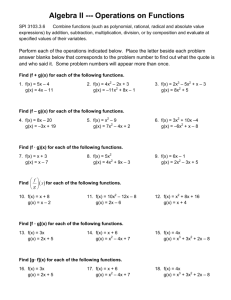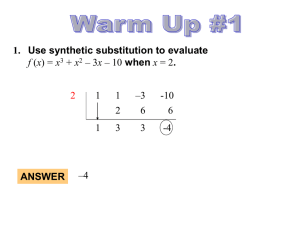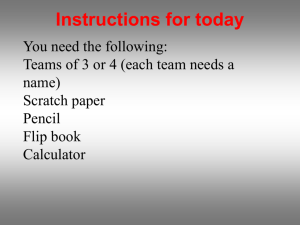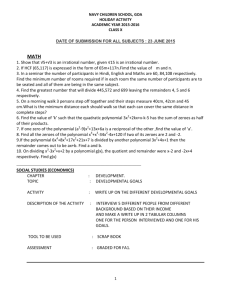lesson 9.1
advertisement
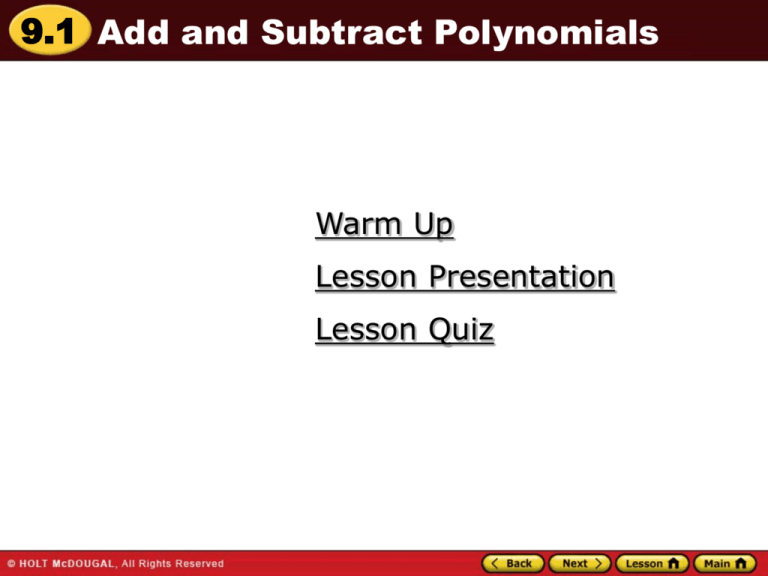
9.1 Add and Subtract Polynomials Warm Up Lesson Presentation Lesson Quiz 9.1 Warm-Up Simplify the expression. 1. 5x + 4(2x + 7) ANSWER 13x + 28 2. 9x – 6(x + 2) + 3 ANSWER 3x – 9 3. Imported square tiles used for a kitchen floor measure 18 centimeters on one side. What is the area of a floor composed of 50 tiles? Use A = s2 for the area of a tile. ANSWER 16,200 cm2 9.1 Example 1 Write 15x – x3 + 3 so that the exponents decrease from left to right. Identify the degree and leading coefficient of the polynomial. SOLUTION Consider the degree of each of the polynomial’s terms. 15x – x3 + 3 The polynomial can be written as – x3 +15 + 3. The greatest degree is 3, so the degree of the polynomial is 3, and the leading coefficient is –1. 9.1 1. Guided Practice Write 5y – 2y2 + 9 so that the exponents decrease from left to right. Identify the degree and leading coefficient of the polynomial. ANSWER – 2y2 +5y + 9 Degree: 2, Leading Coefficient: –2 9.1 Example 2 Tell whether is a polynomial. If it is a polynomial, find its degree and classify it by the number of its terms. Otherwise, tell why it is not a polynomial. Expression Is it a polynomial? Classify by degree and number of terms a. 9 Yes 0 degree monomial b. c. d. e. 2x2 + x – 5 Yes 2nd degree trinomial 6n4 – 8n No; variable exponent n– 2 – 3 No; variable exponent 7bc3 + 4b4c Yes 5th degree binomial 9.1 2. Guided Practice Tell whether y3 – 4y + 3 is a polynomial. If it is a polynomial, find its degree and classify it by the number of its terms. Otherwise, tell why it is not a polynomial. ANSWER polynomial Degree: 3, trinomial 9.1 Example 2 Find the sum. a. (2x3 – 5x2 + x) + (2x2 + x3 – 1) b. (3x2 + x – 6) + (x2 + 4x + 10) SOLUTION a. Vertical format: Align like terms in vertical columns. (2x3 – 5x2 + x) + x3 + 2x2 –1 3x3 – 3x2 + x – 1 9.1 Example 2 b. Horizontal format: Use the associative and commutative properties to group like terms. Then simplify. (3x2 + x – 6) + (x2 + 4x + 10) = (3x2 + x2) + (x + 4x) + (– 6 + 10) = 4x2 + 5x + 4 9.1 3. Guided Practice Find the sum (5x3 + 4x – 2x) + (4x2 +3x3 – 6) . ANSWER = 8x3 + 4x2 + 2x – 6 9.1 Example 4 Find the difference. a. (4n2 + 5) – (–2n2 + 2n – 4) b. (4x2 – 3x + 5) – (3x2 – x – 8) SOLUTION a. (4n2 + 5) –(–2n2 + 2n – 4) 4n2 +5 2n2 – 2n + 4 6n2 – 2n + 9 9.1 Example 4 b. (4x2 – 3x + 5) – (3x2 – x – 8) = 4x2 – 3x + 5 – 3x2 + x + 8 = (4x2 – 3x2) + (–3x + x) + (5 + 8) = x2 – 2x + 13 9.1 4. Guided Practice Find the difference (4x2 – 7x) – (5x2 + 4x – 9) . ANSWER –x2 – 11x + 9 9.1 Example 5 BASEBALL ATTENDANCE Major League Baseball teams are divided into two leagues. During the period 1995–2001, the attendance N and A (in thousands) at National and American League baseball games, respectively, can be modeled by N = –488t2 + 5430t + 24,700 and A = –318t2 + 3040t + 25,600 where t is the number of years since 1995. About how many people attended Major League Baseball games in 2001? 9.1 Example 5 SOLUTION STEP 1 Add the models for the attendance in each league to find a model for M, the total attendance (in thousands). M = (–488t2 + 5430t + 24,700) + (–318t2 + 3040t + 25,600) = (–488t2 – 318t2) + (5430t + 3040t) + (24,700 + 25,600) = –806t2 + 8470t + 50,300 9.1 Example 5 STEP 2 Substitute 6 for t in the model, because 2001 is 6 years after 1995. M = –806(6)2 + 8470(6) + 50,300 72,100 ANSWER About 72,100,000 people attended Major League Baseball games in 2001. 9.1 Guided Practice 5. BASEBALL ATTENDNCE Look back at Example 5. Find the difference in attendance at National and American League baseball games in 2001. ANSWER about 7,320,000 people 9.1 Lesson Quiz If the expression is a polynomial, find its degree and classify it by the number of terms. Otherwise, tell why it is not a polynomial. 1. m3 + n4m2 + m–2 ANSWER 2. No; one exponent is not a whole number. – 3b3c4 – 4b2c + c8 ANSWER 8th degree trinomial 9.1 Lesson Quiz Find the sum or difference. 3. (3m2 – 2m + 9) + (m2 + 2m – 4) ANSWER 4m2 + 5 4. (– 4a2 + 3a – 1) – (a2 + 2a – 6) ANSWER –5a2 + a + 5 5. The number of dog adoptions D and cat adoptions C can be modeled by D = 1.35 t2 – 9.8t + 131 and C= 0.1t2 – 3t + 79 where t represents the years since 1998. About how many dogs and cats were adopted in 2004? ANSWER about 185 dogs and cats


